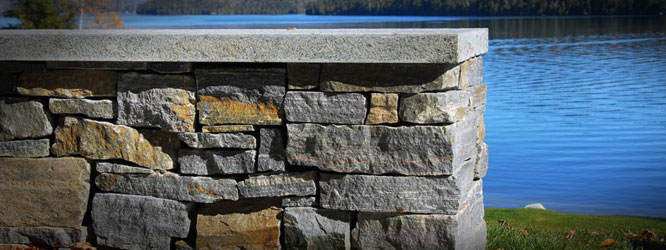retaining walls
Retaining Wall Systems
From a residential backyard to a city street, retaining wall systems will enhance the aesthetics of the natural surroundings and add value to your home or property. We offer many natural and manufactured stone retaining wall systems to fit your needs.
GUIDE TO THE RETAINING WALL
DEFINITION
A retaining wall is a structure designed and constructed to resist the lateral pressure of soil when there is a desired change in ground elevation that exceeds the angle of repose of the soil.
A basement wall is thus one kind of retaining wall. But the term usually refers to a cantilever retaining wall, which is a freestanding structure without lateral support at its top. These are cantilevered from a footing and rise above the grade on one side to retain a higher level grade on the opposite side. The walls must resist the lateral pressures generated by loose soils or, in some cases, water pressures.
Every retaining wall supports a “wedge” of soil. The wedge is defined as the soil which extends beyond the failure plane of the soil type present at the wall site, and can be calculated once the soil friction angle is known. As the setback of the wall increases, the size of the sliding wedge is reduced. This reduction lowers the pressure on the retaining wall.
The most important consideration in proper design and installation of retaining walls is to recognize and counteract the tendency of the retained material to move downslope due to gravity.This creates lateral earth pressure behind the wall which depends on the angle of internal friction (phi) and the cohesive strength of the retained material, as well as the direction and magnitude of movement the retaining structure undergoes.
Lateral earth pressures are zero at the top of the wall and - in homogenous ground - increase proportionally to a maximum value at the lowest depth. Earth pressures will push the wall forward or overturn it if not properly addressed. Also, any groundwater behind the wall that is not dissipated by a drainage system causes hydrostatic pressure on the wall. The total pressure or thrust may be assumed to act at one-third from the lowest depth for lengthwise stretches of uniform height.
Unless the wall is designed to retain water, It is important to have proper drainage behind the wall in order to limit the pressure to the wall's design value. Drainage materials will reduce or eliminate the hydrostatic pressure and improve the stability of the material behind the wall. Drystone retaining walls are normally self-draining.
TYPES OF RETAINING WALLS
GRAVITY WALLS
Gravity walls depend on their mass (stone, concrete or other heavy material) to resist pressure from behind and may have a 'better' setback to improve stability by leaning back toward the retained soil. For short landscaping walls, they are often made from mortarless stone or segmental concrete units (masonry units). Dry-stacked gravity walls are somewhat flexible and do not require a rigid footing in frost areas. Home owners who build larger gravity walls that do require a rigid concrete footing can make use of the services of a professional excavator, which will make digging a trench for the base of the gravity wall much easier.
Earlier in the 20th century, taller retaining walls were often gravity walls made from large masses of concrete or stone. Today, taller retaining walls are increasingly built as composite gravity walls such as: geosynthetic or with precast facing; gabions (stacked steel wire baskets filled with rocks); crib walls (cells built up log cabin style from precast concrete or timber and filled with soil); or soil-nailed walls (soil reinforced in place with steel and concrete rods).
CANTILEVERD
Cantilevered retaining walls are made from an internal stem of steel-reinforced, cast-in-place concrete or mortared masonry (often in the shape of an inverted T). These walls cantilever loads (like a beam) to a large, structural footing, converting horizontal pressures from behind the wall to vertical pressures on the ground below. Sometimes cantilevered walls are buttressed on the front, or include a counterfort on the back, to improve their strength resisting high loads. Buttresses are short wing walls at right angles to the main trend of the wall. These walls require rigid concrete footings below seasonal frost depth. This type of wall uses much less material than a traditional gravity wall.
SHEET PILING
Sheet pile retaining walls are usually used in soft soils and tight spaces. Sheet pile walls are made out of steel, vinyl or wood planks which are driven into the ground. For a quick estimate the material is usually driven 1/3 above ground, 2/3 below ground, but this may be altered depending on the environment. Taller sheet pile walls will need a tie-back anchor, or "dead-man" placed in the soil a distance behind the face of the wall, that is tied to the wall, usually by a cable or a rod. Anchors are then placed behind the potential failure plane in the soil.
ANCHORED
An anchored retaining wall can be constructed in any of the aforementioned styles but also includes additional strength using cables or other stays anchored in the rock or soil behind it. Usually driven into the material with boring, anchors are then expanded at the end of the cable, either by mechanical means or often by injecting pressurized concrete, which expands to form a bulb in the soil. Technically complex, this method is very useful where high loads are expected, or where the wall itself has to be slender and would otherwise be too weak.
ALTERNATIVE RETAINING TECHNIQUES
SOIL NAILING
Soil nailing is a technique in which soil slopes, excavations or retaining walls are reinforced by the insertion of relatively slender elements - normally steel reinforcing bars. The bars are usually installed into a pre-drilled hole and then grouted into place or drilled and grouted simultaneously. They are usually installed untensioned at a slight downward inclination. A rigid or flexible facing (often sprayed concrete) or isolated soil nail heads may be used at the surface.
SOIL STRENGTHENED
A number of systems exist that do not simply consist of the wall itself, but reduce the earth pressure acting on the wall itself. These are usually used in combination with one of the other wall types, though some may only use it as facing (i.e. for visual purposes).
GABION MESHES
This type of soil strengthening, often also used without an outside wall, consists of wire mesh 'boxes' into which roughly cut stone or other material is filled. The mesh cages reduce some internal movement/forces, and also reduce erosive forces.
MECHANICAL STABLIZATION
Mechanically stabilized earth, also called MSE, is soil constructed with artificial reinforcing via layered horizontal mats fixed at their ends. These mats provide added internal shear resistance beyond that of simple gravity wall structures. Other options include steel straps, also layered. This type of soil strengthening usually needs outer facing walls (S.R.W.'s - Segmental Retaining Walls) to affix the layers to and vice versa.
The wall face is often of precast concrete units that can tolerate some differential movement. The reinforced soil's mass, along with the facing, then acts as an improved gravity wall. The reinforced mass must be built large enough to retain the pressures from the soil behind it. Gravity walls usually must be a minimum of 50 to 60 percent as deep or thick as the height of the wall, and may have to be larger if there is a slope or surcharge on the wall.
Cellular confinement systems are also used for steep earth stabilization in gravity and reinforced retaining walls with geogrids. Geocell retaining walls are structurally stable under self- weight and externally imposed loads, while the flexibility of the structure offers very high seismic resistance. The outer fascia cells of the wall can be planted with vegetation to create a green wall.

